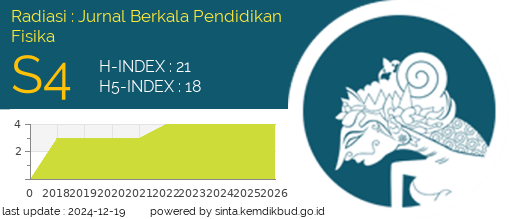Effectiveness of Android-Based Waterwheel Teaching Aid to Improve Students' Critical Thinking Skills
Abstract
A study has been carried out on android-based waterwheel props used for dynamic fluid learning. The aim is to increase skills of critical thinking of students. The research subjects were 22 students of the sixth semester of Physics Education Study Program, Faculty of Teacher Training and Education, Muhammadiyah University of Purworejo. The implementation of the research is: before learning students are given a pretest of skills of critical thinking, then learning is carried out using an android-based waterwheel prop, then given a posttest with questions that weigh the same as the pretest questions. Furthermore, n-gain was calculated from the pretest-posttest tests of critical thinking skills, and analyzed by parametric and/or non-parametric analysis of statistical. The results of this study is a significant increase in skills of critical thinking at the 5% significance level with an average n-gain greater than 0.7 which means in the high category, and the Anova test produces a Sig score. of 0.342 which means it is greater than the probability score of 0.05 so that Anova test results show that there are similarities in the improvement of skills of critical thinking in the two learning meetings.
Downloads
References
S. N. Ismail, Y. Don, F. Husin, & R. Khalid, “Instructional leadership and teachers’ functional competency across the 21st century learning,” International Journal of Instruction, vol. 11, no. 3, hlm. 135-152, July 2018, https://doi.org/10.12973/iji.2018.11310a.
E. Y. S. Asmawati (2016), “Student worksheet (LKS) using guided inquiry model to improve critical thinking skill and mastery of student concept,” Jurnal Pendidikan Fisika Universitas Muhammadiyah Metro, 3(1), 1-16, March 2015, DOI:10.24127/jpf.v3i1.13.
R. W. Akhdinirwanto, R. Agustini, dan B. Jatmiko, “Validitas model PBMA untuk meningkatkan keterampilan berpikir kritis siswa SMP,” Prosiding Seminar Nasional Pendidikan Sains PPs UNESA, hlm. D269-D277, Januari 2017.
S. A. Hadi, E. Susantini, dan R. Agustini, “Training of students’ critical thinking skills through the implementation of a modified free inquiry model,” In Journal of Physics: Conference Series, vol. 947, no. 1, hlm. 2-6. September 2017, IOP Publishing Ltd.
H. Ruwaida, “Proses kognitif dalam Taksonomi Bloom Revisi : Analisis kemampuan mencipta (C6) pada pembelajaran fikih di MI Miftahul Anwar Desa Banua Lawas,” Al-Madrasah: Jurnal Ilmiah Pendidikan Madrasah Ibtidaiyah, vol. 4, no. 1, Juli-Desember 2019.
PISA, “Assessment And Analytical Framework © OECD 2019”, April 2019.
L. Herayanti, M. Fuaddunnazmi, dan H. Habibi, “Pengembangan perangkat pembelajaran fisika berbasis moodle,” Jurnal Pedidikan Fisika dan Teknologi, vol. 3, no. 2, hlm. 197-206, Desember 2017, DOI: 10.29303/jpft.v3i2.412.
N. Najikhah, R. W. Akhdinirwanto, dan Ashari, “Perancangan alat peraga kincir air berbasis android pada pembelajaran fluida dinamis,” Jurnal Inovasi Pendidikan Sains (JIPS), vol. 2, no. 1, hlm. 9-17. Mei 2021, DOI: https://doi.org/10.37729/jips.v2i1.585.
R. T. Hake, “Analyzing change/gain score. American educationl research assosiation’s division measurement and research methodology,” Feb 1999.
P. Pandiangan, I. G. M. Sanjaya, dan B. Jatmiko, “The validity and effectiveness of physics independent learning model to improve physics problem solving and self-directed learning skills of students in open and distance education systems,” Journal of Baltic Science Education, vol. 16, no. 5, hlm. 651-665, Aug 2017, Doi: 10.33225/jbse/17.16.651.
S. Asmara dan A. Putra, “Analisis kebutuhan bahan ajar fisika ditinjau dari kompleksitas proses kognitif menurut Taksonomi Bloom revisi pada materi hukum newton tentang gerak di SMAN Kota Padang,” Pillar of Physics Education, vol. 13, no. 3, hlm. 364-370, 2020, DOI: http://dx.doi.org/10.24036/8614171074
SPSS Indonesia, “Cara melakukan uji normalitas Kolmogorov-Smirnov dengan SPSS,” Diakses pada 19 Juli 2021 dari laman: http://www.spssindonesia.com/2014/01/uji-normalitas-kolmogorov-smirn ov-spss.html, 2014.
SPSS Indonesia, “Cara melakukan uji homogenitas dengan Levene Test dengan SPSS,“ Diakses pada 19 Juli 2021 dari laman https://www.spssindonesia.com/2014/02/uji-homogenitas-dengan-spss.html, 2014.
SPSS Indonesia, “Cara melakukan Uji Wilcoxon dengan SPSS,” Diakses pada 19 Julii 2021 dari laman https://www.spssindonesia.com/2017/04/cara-uji-wilcoxon-spss.html, 2014.
SPSS Indonesia, “Cara melakukan Uji Anova dengan SPSS,” Diakses pada 21 Juli 2021 dari laman https://www.spssindonesia.com/2017/10/analisis-anova-satu-faktor-spss.html, 2014.
O. S. Henry, A. Daud, dan H. Hakki, “Analisis perubahan dimensi kincir air terhadap kecepatan aliran air (Studi Kasus Desa Pandan Enim),” Jurnal Teknik Sipil dan Lingkungan, vol. 1, no. 1, hlm. 1-4, Desember 2013.
Z. Zulkarnain, Y. Andayani, dan S. Hadisaputro, “Peningkatan keterampilan berpikir kritis peserta didik pada pembelajaran kimia menggunakan model pembelajaran preparing dong concluding,” Jurnal Pijar MIPA, vol. 14, no. 2, hlm. 96-100, Juni 2019, DOI: 10.29303/jpm.v14i2.1321.
H. Munandar, Sutrio, dan M. Taufik, “Pengaruh model pembelajaran berbasis masalah berbantuan media animasi terhadap kemampuan berpikir kritis dan hasil belajar fisika siswa SMAN 5 Mataram tahun ajaran 2016/2017,” Jurnal Pendidikan Fisika dan Teknologi, vol. 4, no.1, hlm. 111-120, Mei 2018, DOI: 10.29303/jpft.v4i1.526.
E. Rukmini, “Deskripsi Singkat Revisi Taksonomi Bloom,” https://journal.uny.ac.id/index.php/mip/article/view/7132. 2008.
R. W. Akhdinrwanto, R. Agustini, dan B. Jatmiko, “Problem-based learning with argumentation as a hypothetical model to increase the critical thinking skills for junior high school students,” Jurnal Pendidikan IPA Indonesia, vol. 9, no. 3, hlm. 340-350, 2020, DOI: https://doi.org/10.15294/jpii.v9i3.19282.
W. S. Kuswana, “Thinking Taxonomy,” Bandung: Remaja Rosdakarya, 2013.
P. Budsankom, T. Sawangboon, dan S. Damrongpanit, “Factors affecting higher order thinking skills of students : a meta-analytic structural equation modeling study,” Educational Research and Review, vol. 10, no. 19, hlm. 2639–2652, October 2015, DOI: 10.5897/ERR2015. 2371.
A. C. Saputri, Sajidan, Y. Rinanto, Afandi, dan N. M. Prasetyanti, “Improving Students’ Critical Thinking Skills in Cell-Metabolism Learning Using Stimulating Higher Order Thinking Skills Model,” International Journal of Instruction, vol. 12, no. 1, hlm. 327-342, Jan 2019, DOI:10.29333/iji.2019.12122a.
Copyright (c) 2022 Raden Wakhid Akhdinirwanto, Nisrina Najikhah, Ashari Ashari, Nasrun Balulu

This work is licensed under a Creative Commons Attribution-NonCommercial 4.0 International License.




